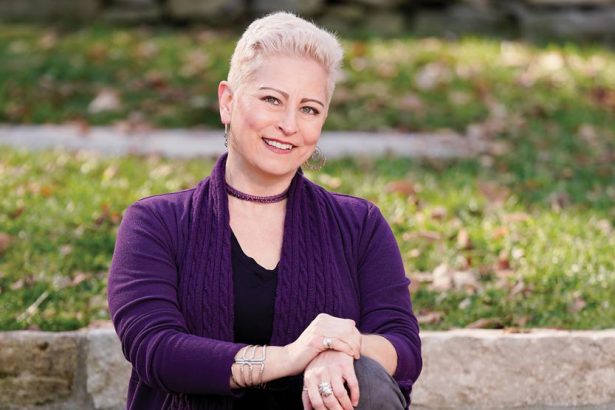Patient Search
 |
 |
|
KaCrole Higgins was diagnosed with breast cancer in 2020. “In May 2020, I found a lump in my breast. I cried. By June, it was diagnosed as breast cancer, triple positive, stage 1A. While getting this cancer diagnosis was devastating, it also became an opportunity. Suddenly, the cancer gave me clarity. It gave me clarity about what was important, what was good in my life, what was toxic in my life, and what I needed to do.” Click below to read more of KaCrole’s story |
If Landon Ryan had been diagnosed with bilateral retinoblastoma 10, 20 or 30 years ago, she might not be here today with nearly perfect vision.Thanks to recent improvements in the treatment for this rare form of cancer that almost exclusively affects children under the age of 5, the diagnosis had the power to change Landon’s life when she was 11 months old, but not to take it — or her eyesight. Click below to learn more about Landon and her story. https://momentum.vicc.org/2022/04/brighter-outlook/ |
Mismatched Related Donor versus Matched Unrelated Donor Stem Cell Transplantation for Children, Adolescents, and Young Adults with Acute Leukemia or Myelodysplastic Syndrome
Multiple Cancer Types
This phase III trial compares hematopoietic (stem) cell transplantation (HCT) using mismatched related donors (haploidentical [haplo]) versus matched unrelated donors (MUD) in treating children, adolescents, and young adults with acute leukemia or myelodysplastic syndrome (MDS). HCT is considered standard of care treatment for patients with high-risk acute leukemia and MDS. In HCT, patients are given very high doses of chemotherapy or radiation therapy, which is intended to kill cancer cells that may be resistant to more standard doses of chemotherapy; unfortunately, this also destroys the normal cells in the bone marrow, including stem cells. After the treatment, patients must have a healthy supply of stem cells reintroduced or transplanted. The transplanted cells then reestablish the blood cell production process in the bone marrow. The healthy stem cells may come from the blood or bone marrow of a related or unrelated donor. If patients do not have a matched related donor, doctors do not know what the next best donor choice is or if a haplo related donor or MUD is better. This trial may help researchers understand whether a haplo related donor or a MUD HCT for children with acute leukemia or MDS is better or if there is no difference at all.
Leukemia,
Myelodysplastic Syndrome,
Pediatric Leukemia,
Pediatric Lymphoma,
Pediatrics
III
Kitko, Carrie
NCT05457556
COGASCT2031
Selinexor and Venetoclax in Combination with Chemotherapy for the Treatment of Relapsed or Refractory Acute Myeloid Leukemia or Acute Leukemia of Ambiguous Lineage
Multiple Cancer Types
This phase I trial evaluates the side effects and best dose of selinexor and venetoclax in combination with chemotherapy in treating patients with acute myeloid leukemia or acute leukemia of ambiguous linage that has come back (relapsed) or does not respond to treatment. Venetoclax may stop the growth of cancer cells by blocking Bcl-2, a protein needed for cancer cell survival. Selinexor may stop the growth of cancer cells by blocking CRM1, which help the body's immune system to find and kill cancer cells. Chemotherapy drugs, such as fludarabine and cytarabine, work in different ways to stop the growth of cancer cells, either by killing the cells, by stopping them from dividing, or by stopping them from spreading. Colony-stimulating factors, such as granulocyte colony-stimulating factor, may increase the production of blood cells and may help the immune system recover from the side effects of chemotherapy. Giving venetoclax and selinexor with chemotherapy may help control the disease in patients with acute myeloid leukemia or acute leukemia of ambiguous lineage.
Leukemia,
Pediatric Leukemia,
Pediatrics,
Phase I
I
Smith, Brianna
NCT04898894
VICCPEDP2235
First in Human Study of Ziftomenib in Relapsed or Refractory Acute Myeloid Leukemia
Multiple Cancer Types
This first-in-human (FIH) dose-escalation and dose-validation/expansion study will assess
ziftomenib, a menin-MLL(KMT2A) inhibitor, in patients with relapsed or refractory acute
myeloid leukemia (AML) as part of Phase 1. In Phase 2, assessment of ziftomenib will continue
in patients with NPM1-m AML.
ziftomenib, a menin-MLL(KMT2A) inhibitor, in patients with relapsed or refractory acute
myeloid leukemia (AML) as part of Phase 1. In Phase 2, assessment of ziftomenib will continue
in patients with NPM1-m AML.
Leukemia,
Phase I
I/II
Savona, Michael
NCT04067336
VICCHEMP20122
HLA-Mismatched Unrelated Donor Hematopoietic Cell Transplantation With Post-Transplantation Cyclophosphamide
Multiple Cancer Types
This is a prospective, multi-center, Phase II study of hematopoietic cell transplantation
(HCT) using human leukocyte antigen (HLA)-mismatched unrelated donors (MMUD) for peripheral
blood stem cell transplant in adults and bone marrow stem cell transplant in children.
Post-transplant cyclophosphamide (PTCy), tacrolimus and mycophenolate mofetil (MMF) will be
used for for graft versus host disease (GVHD) prophylaxis. This trial will study how well
this treatment works in patients with hematologic malignancies.
(HCT) using human leukocyte antigen (HLA)-mismatched unrelated donors (MMUD) for peripheral
blood stem cell transplant in adults and bone marrow stem cell transplant in children.
Post-transplant cyclophosphamide (PTCy), tacrolimus and mycophenolate mofetil (MMF) will be
used for for graft versus host disease (GVHD) prophylaxis. This trial will study how well
this treatment works in patients with hematologic malignancies.
Hematologic,
Leukemia,
Lymphoma,
Myelodysplastic Syndrome
II
Dholaria, Bhagirathbhai
NCT04904588
VICCCTT2171
Pharmacokinetics, Safety, and Efficacy of ASTX727 in Combination With Venetoclax in Acute Myeloid Leukemia (AML)
Multiple Cancer Types
The Phase 1 portion of this study is a single-arm, open-label, multicenter, non-randomized
interventional study to evaluate the pharmacokinetic (PK) interaction, safety, and efficacy
of ASTX727 when given in combination with venetoclax for the treatment of newly diagnosed
acute myeloid leukemia (AML) in adults who are age 75 years or older, or who have
comorbidities that preclude use of intensive induction chemotherapy. The primary purpose of
the study is to rule out drug-drug interactions between ASTX727 and venetoclax combination
therapy by evaluating area under the curve (AUC) and maximum plasma concentration (Cmax)
exposure. The Phase 2 portion of the study is to assess the efficacy of ASTX727 and
venetoclax when given in combination and to evaluate potential PK interactions. Phase 2 will
follow the same overall study design as Phase 1 and has two parts, Part A and Part B.
interventional study to evaluate the pharmacokinetic (PK) interaction, safety, and efficacy
of ASTX727 when given in combination with venetoclax for the treatment of newly diagnosed
acute myeloid leukemia (AML) in adults who are age 75 years or older, or who have
comorbidities that preclude use of intensive induction chemotherapy. The primary purpose of
the study is to rule out drug-drug interactions between ASTX727 and venetoclax combination
therapy by evaluating area under the curve (AUC) and maximum plasma concentration (Cmax)
exposure. The Phase 2 portion of the study is to assess the efficacy of ASTX727 and
venetoclax when given in combination and to evaluate potential PK interactions. Phase 2 will
follow the same overall study design as Phase 1 and has two parts, Part A and Part B.
Leukemia,
Phase I
I/II
Savona, Michael
NCT04657081
VICCHEMP20102
Testing the Use of Steroids and Tyrosine Kinase Inhibitors with Blinatumomab or Chemotherapy for Newly Diagnosed BCR-ABL-Positive Acute Lymphoblastic Leukemia in Adults
Leukemia
Leukemia
This phase III trial compares the effect of usual treatment of chemotherapy and steroids and a tyrosine kinase inhibitor (TKI) to the same treatment plus blinatumomab. Blinatumomab is a Bi-specific T-Cell Engager (BiTE) that may interfere with the ability of cancer cells to grow and spread. The information gained from this study may help researchers determine if combination therapy with steroids, TKIs, and blinatumomab work better than the standard of care.
Leukemia
III
Mohan, Sanjay
NCT04530565
ECOGHEMEA9181
Decitabine and Cedazuridine in Combination with Venetoclax for the Treatment of Patients who have Relapsed Acute Myeloid Leukemia after Donor Stem Cell Transplant
Leukemia
Leukemia
This phase II trial tests how well decitabine and cedazuridine (DEC-C) works in combination with venetoclax in treating acute myeloid leukemia (AML) in patients whose AML has come back after a period of improvement (relapse) after a donor stem cell transplant. Cedazuridine is in a class of medications called cytidine deaminase inhibitors. It prevents the breakdown of decitabine, making it more available in the body so that decitabine will have a greater effect. Decitabine is in a class of medications called hypomethylation agents. It works by helping the bone marrow produce normal blood cells and by killing abnormal cells in the bone marrow. Venetoclax is in a class of medications called B-cell lymphoma-2 (BCL-2) inhibitors. It may stop the growth of cancer cells by blocking Bcl-2, a protein needed for cancer cell survival. Giving DEC-C in combination with venetoclax may kill more cancer cells in patients with relapsed AML.
Leukemia
II
Mohan, Sanjay
NCT05799079
VICCHEM2163
A Study of ASTX030 (Cedazuridine in Combination With Azacitidine) in MDS, CMML, or AML
Multiple Cancer Types
Study ASTX030-01 is designed to move efficiently from Phase 1 to Phase 3. Phase 1 consists of
an open-label Dose Escalation Stage (Stage A) using multiple cohorts at escalating dose
levels of oral cedazuridine and azacitidine (only one study drug will be escalated at a time)
followed by a Dose Expansion Stage (Stage B) of ASTX030. Phase 2 is a randomized open-label
crossover study to compare oral ASTX030 to subcutaneous (SC) azacitidine. Phase 3 is a
randomized open-label crossover study comparing the final oral ASTX030 dose to SC
azacitidine. The duration of the study is expected to be approximately 48 months.
an open-label Dose Escalation Stage (Stage A) using multiple cohorts at escalating dose
levels of oral cedazuridine and azacitidine (only one study drug will be escalated at a time)
followed by a Dose Expansion Stage (Stage B) of ASTX030. Phase 2 is a randomized open-label
crossover study to compare oral ASTX030 to subcutaneous (SC) azacitidine. Phase 3 is a
randomized open-label crossover study comparing the final oral ASTX030 dose to SC
azacitidine. The duration of the study is expected to be approximately 48 months.
Leukemia,
Myelodysplastic Syndrome,
Phase I
I/II/III
Savona, Michael
NCT04256317
VICCHEMP19146
A Study to Evaluate INCA033989 Administered in Participants With Myeloproliferative Neoplasms
Leukemia
Leukemia
This study is being conducted to evaluate the safety, tolerability, dose-limiting toxicity
(DLT) and determine the maximum tolerated dose (MTD) and/or recommended dose(s) for expansion
(RDE) of INCA033989 administered in participants with myeloproliferative neoplasms.
(DLT) and determine the maximum tolerated dose (MTD) and/or recommended dose(s) for expansion
(RDE) of INCA033989 administered in participants with myeloproliferative neoplasms.
Leukemia
I
Savona, Michael
NCT06034002
VICC-DTHEM23416P
FHD-286 as Monotherapy or Combination Therapy in Subjects With Advanced Hematologic Malignancies
Multiple Cancer Types
This Phase 1, multicenter, open-label, dose escalation study is designed to assess the
safety, tolerability, pharmacokinetics (PK), pharmacodynamics (PD), and preliminary clinical
activity of FHD-286 administered orally as monotherapy or combination therapy, in subjects
with advanced hematologic malignancies.
safety, tolerability, pharmacokinetics (PK), pharmacodynamics (PD), and preliminary clinical
activity of FHD-286 administered orally as monotherapy or combination therapy, in subjects
with advanced hematologic malignancies.
Leukemia,
Myelodysplastic Syndrome,
Phase I
I
Kishtagari, Ashwin
NCT04891757
VICCHEMP2138



